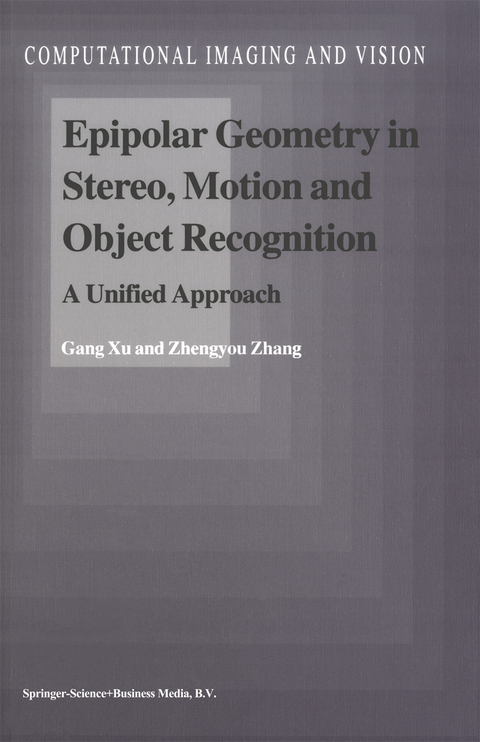
Epipolar Geometry in Stereo, Motion and Object Recognition
A Unified Approach
Seiten
1996
Springer (Verlag)
978-0-7923-4199-4 (ISBN)
Springer (Verlag)
978-0-7923-4199-4 (ISBN)
2 Estimation of Affine Transformation 165 4 RECOVERY OF EPIPOLAR GEOMETRY FROM LINE SEGMENTS OR LINES 167 Line Segments or Straight Lines 168 4. 2 Solving Motion Using Line Segments Between Two Views 173 4. 4 Determining Camera Projection Matrices 201 4. 4 Summary 204 5 REDEFINING STEREO, MOTION AND OBJECT RECOGNITION VIA EPIPOLAR GEOMETRY 205 5.
Appendix 164 3. A 3. A. 1 Approximate Estimation of Fundamental Matrix from General Matrix 164 3. A. 2 Estimation of Affine Transformation 165 4 RECOVERY OF EPIPOLAR GEOMETRY FROM LINE SEGMENTS OR LINES 167 Line Segments or Straight Lines 168 4. 1 4. 2 Solving Motion Using Line Segments Between Two Views 173 4. 2. 1 Overlap of Two Corresponding Line Segments 173 Estimating Motion by Maximizing Overlap 175 4. 2. 2 Implementation Details 4. 2. 3 176 Reconstructing 3D Line Segments 4. 2. 4 179 4. 2. 5 Experimental Results 180 4. 2. 6 Discussions 192 4. 3 Determining Epipolar Geometry of Three Views 194 4. 3. 1 Trifocal Constraints for Point Matches 194 4. 3. 2 Trifocal Constraints for Line Correspondences 199 4. 3. 3 Linear Estimation of K, L, and M Using Points and Lines 200 4. 3. 4 Determining Camera Projection Matrices 201 4. 3. 5 Image Transfer 203 4. 4 Summary 204 5 REDEFINING STEREO, MOTION AND OBJECT RECOGNITION VIA EPIPOLAR GEOMETRY 205 5. 1 Conventional Approaches to Stereo, Motion and Object Recognition 205 5. 1. 1 Stereo 205 5. 1. 2 Motion 206 5. 1. 3 Object Recognition 207 5. 2 Correspondence in Stereo, Motion and Object Recognition as 1D Search 209 5. 2. 1 Stereo Matching 209 xi Contents 5. 2. 2 Motion Correspondence and Segmentation 209 5. 2. 3 3D Object Recognition and Localization 210 Disparity and Spatial Disparity Space 210 5.
Appendix 164 3. A 3. A. 1 Approximate Estimation of Fundamental Matrix from General Matrix 164 3. A. 2 Estimation of Affine Transformation 165 4 RECOVERY OF EPIPOLAR GEOMETRY FROM LINE SEGMENTS OR LINES 167 Line Segments or Straight Lines 168 4. 1 4. 2 Solving Motion Using Line Segments Between Two Views 173 4. 2. 1 Overlap of Two Corresponding Line Segments 173 Estimating Motion by Maximizing Overlap 175 4. 2. 2 Implementation Details 4. 2. 3 176 Reconstructing 3D Line Segments 4. 2. 4 179 4. 2. 5 Experimental Results 180 4. 2. 6 Discussions 192 4. 3 Determining Epipolar Geometry of Three Views 194 4. 3. 1 Trifocal Constraints for Point Matches 194 4. 3. 2 Trifocal Constraints for Line Correspondences 199 4. 3. 3 Linear Estimation of K, L, and M Using Points and Lines 200 4. 3. 4 Determining Camera Projection Matrices 201 4. 3. 5 Image Transfer 203 4. 4 Summary 204 5 REDEFINING STEREO, MOTION AND OBJECT RECOGNITION VIA EPIPOLAR GEOMETRY 205 5. 1 Conventional Approaches to Stereo, Motion and Object Recognition 205 5. 1. 1 Stereo 205 5. 1. 2 Motion 206 5. 1. 3 Object Recognition 207 5. 2 Correspondence in Stereo, Motion and Object Recognition as 1D Search 209 5. 2. 1 Stereo Matching 209 xi Contents 5. 2. 2 Motion Correspondence and Segmentation 209 5. 2. 3 3D Object Recognition and Localization 210 Disparity and Spatial Disparity Space 210 5.
1 Introduction.- 2 Camera Models and Epipolar Geometry.- 3 Recovery of Epipolar Geometry from Points.- 4 Recovery of Epipolar Geometry from Line Segments or Lines.- 5 Redefining Stereo, Motion and Object Recognition Via Epipolar Geometry.- 6 Image Matching and Uncalibrated Stereo.- 7 Multiple Rigid Motions: Correspondence and Segmentation.- 8 3D Object Recognition and Localization.- 9 Concluding Remarks.- References.
| Erscheint lt. Verlag | 30.9.1996 |
|---|---|
| Reihe/Serie | Computational Imaging and Vision ; 6 |
| Zusatzinfo | XIX, 316 p. |
| Verlagsort | Dordrecht |
| Sprache | englisch |
| Maße | 156 x 234 mm |
| Themenwelt | Informatik ► Grafik / Design ► Digitale Bildverarbeitung |
| Informatik ► Theorie / Studium ► Künstliche Intelligenz / Robotik | |
| ISBN-10 | 0-7923-4199-6 / 0792341996 |
| ISBN-13 | 978-0-7923-4199-4 / 9780792341994 |
| Zustand | Neuware |
| Haben Sie eine Frage zum Produkt? |
Mehr entdecken
aus dem Bereich
aus dem Bereich
Modelle für 3D-Druck und CNC entwerfen
Buch | Softcover (2022)
dpunkt (Verlag)
CHF 48,85
alles zum Drucken, Scannen, Modellieren
Buch | Softcover (2024)
Markt + Technik Verlag
CHF 34,90


